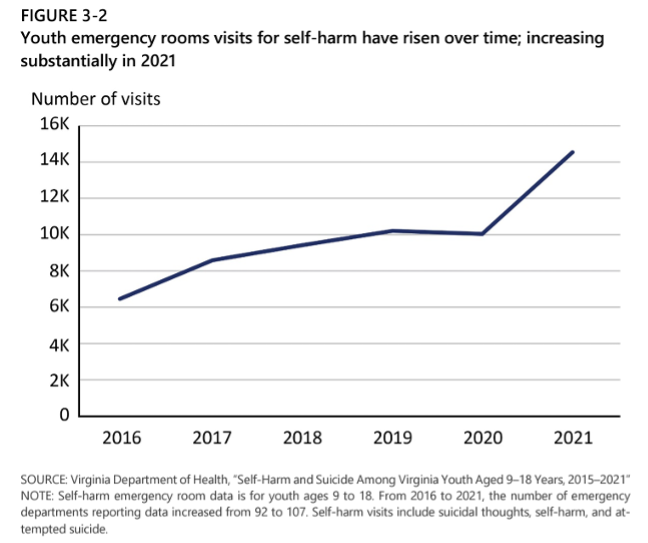

Whether you are a young person, a parent, a mental health professional, or an educator, you have likely heard about the youth mental health crisis in the United States—it is being discussed everywhere, from kitchen tables to news stations to the Governor’s office. And while there is finally urgency around addressing the mental health needs of Virginians, we continue to see a catch-all response for adult and children’s mental health needs in our current policies. It is undoubtedly easier to design mental and behavioral health systems and services for adults and retrofit young people into them, but this results in supports that inadequately meet the needs of children and youth. To truly invest in the mental health of young people, policymakers must do so with intention. It requires centering the needs and experiences of young people—especially those who are Black, Latino, and LGBTQ+—and developing mental health services that prioritize healing and well-being.
The past few years have been particularly difficult for young people. The Joint Legislative Audit & Review Commission’s (JLARC) November 2022 report shared several alarming statistics that articulate the dire need to intervene and support young people right now:

This constitutes a youth mental health crisis. In order to meet this moment for youth mental health, there must be major shifts in how children and youth are prioritized in our system. Historically, new initiatives and service expansions have delayed the implementation of child- and youth-focused plans until phase two—a step that often takes too long to achieve. Mental health resources that are not intentionally designed to reach children and youth will not reach them.
Capacity to build up the infrastructure at local Community Services Boards, particularly for children and youth, is needed. The ideal system offers young people mental health support when and where they need it, but the reality is children and youth do not have access to a comprehensive array of crisis response services depending on where they live, who pays for their care, and who helps them identify resources.
Currently, there are only three Residential Crisis Stabilization Units (RCSUs) specifically for young people across the Commonwealth. One goal of Governor Youngkin’s “Right Help. Right Now.” behavioral health transformation initiativeis to add more youth RCSUs and to develop 23-hour Crisis Receiving Centers (CRCs) to serve as a “behavioral health urgent care”, both of which are critical components of the crisis services continuum. However, if the locations and services are not developed with young people’s needs in mind, they will not be as effective of a resource. Having a cross-lifespan model for RCSUs and CRCs that only incorporate child-sized recliners does not make a space child- and youth-friendly. The design of RCSUs and CRCs must be fundamentally different from the design of a traditional hospital, which are often sterile and unwelcoming environments. Young people need culturally and developmentally appropriate resources in these locations, such as places for their family members to rest, blankets, sensory toys and comfort items, and a warm and inviting environment to encourage healing and create emotional and physical safety.
Virginia lawmakers have a chance to reimagine what it means to put young people’s needs at the forefront of their decision-making during the 2023 General Assembly session. Between Governor Youngkin’s proposed budget and several budget amendments before the legislature, there are opportunities to ensure behavioral health services are available in every region and designed with the needs of children and youth in mind. This includes expanding crisis response services with components specific to children and youth and providing adequate resources to build the capacity of the system.